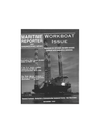
Page 65: of Maritime Reporter Magazine (November 1995)
Read this page in Pdf, Flash or Html5 edition of November 1995 Maritime Reporter Magazine
••• WORKBOATS < l ^FtlwBrTlrW^*
Workboat Sector Mirrors Industry Trends
An artist's conception of the Elliott Bay tug design recently contracted by Crowley Marine for the construction of two new-generation vessels. by Bridget A. Murphy, assistant editor
The workboat market is a dynamic one, with much attention paid to technological improvements in the areas of propulsion and electronics. Vessels in this cate- gory are not only constructed for a specific function — with the newbuild market driven by task-specific design — but contain the latest in technical equipment and high-power, high-efficiency propulsion systems, mini- mizing the requirements for maximum operation and manueverability. Possibly the hardest working vessel afloat, the workboat has always been the beneficiary of technological advances aimed at making it ever better at its job — providing higher power coupled with better fuel economy, increased seaworthiness, longer mainte- nance intervals, and compliance with higher environ- mental standards.
Added to these factors is the effect legislation and reg- ulations, including OPA 90 and MARPOL, have on workboats — a category including tug escort and ship assist vessels, patrol boats, and oil spill response ves- sels. These changing laws — combined with significant technological improvements, have catapulted workboat designs forward. A segment of the industry sometimes overlooked, workboats are as vital to the balance of trade and commerce as containerships, as evidenced by their adaptability, functionality, and comparatively low- cost production figures.
One trend in the workboat sector is the movement towards higher power propulsion. A reason for this increase in power, as seen in tugboat applications, is the growth in the size of towable vessels. Bigger ships are
Moen Slip Delivers Voith Tractor Tug To Roda
Bolaget
Gothenburg-based Roda Bolaget AB has just taken delivery of a new water tractor tug. This vessel, the 496-gt Boss, is the com- pany's first Voith Schneider-propelled water tractor and is pri- marily intended for ship handling and escort duties on Sweden's west coast. It will also be usea for a range of support duties, including firefighting and oil recovery at Sweden's largest oil ter- minals.
The Boss was constructed at Moen Slip AS, Kolvereid, Norway, and is a sister to the Bess, of Buker og Bjergning, the Norwegian towing partner of Roda Bolaget within the Neptune (Platou)
Marine Group.
Classed by Det Norske Veritas and with a length of 119 ft. (36.3 m), a maximum beam of 40.4 ft. (12.3 m) and a maximum draft of 17 ft. (5.2 m), the multipurpose capability of the Boss makes it a valuable addition to the Roda Bolaget fleet.
The two Voith Schneider units — model 32G 11/200 — are powered by a pair of Ulstein Bergen KRMB9 diesel engines, each rated at 2,730 bhp, giving the Boss a bollard pull of 57 tons and a free running speed of about 15 knots. Use of the Voith
Schneider design of cycloidal propeller reportedly gives superb handling and thrust, which can be immediately directed at any angle throughout the full 360 degrees.
A comprehensive array of dec< equipment has been fitted for the vessel, including a forward-mounted 100-ton Karmoy towing winch and 65-ton towing hook, 8-ton winches forward and aft of the superstructure, a 22-ton-meter crane, and a 65-hp Viking man-overboard boat.
The navigation and communications outfit is also extensive. An
Atlas 9600 ARPA and JFS 364 radar are fitted together with a
JRC V-720 echosounder, Decca Mk5 AP navigator, Adveto data navigation system — which includes a 12-channel differential
GPS receiver, a Robertson AP 9 Mk 11 autopilot and RGC 11 gyro, and a JRC JLN 203 speed log.
Communications systems include a Sailor RT 2047 Duplex and
RT 2048 VHF sets, a Skanti TRP 3000 VHF set, a TRP 7201 watch receiver, a WR 6000 watchkeeping receiver, and 7200 HF/MF set, and DSC 3000 VHF and 9000 HF/MF sets.
For more information on Voith Schneider
Circle 127 on Reader Service Card
Winninghoff 29-Ft. Workboat Built To
Weather 12-Ft. Waves
After an intensive, five-year effort, Millord Fire Department,
Milford, Conn., has taken delivery of a Response FR-8.9 fire/res- cue boat. Designed by Response Marine, Inc., and constructed of welded aluminum by Winninghoff Boats, Inc., the 29-ft. (8.8-m) vessel is a custom design. Twin 225-hp outboards propel the 10,000-lb., shallow draft vessel to a top speed of 42 mph.
Outfitting includes extensive electronics, dive rescue equipment, and EMS facilities, as well as a Hale 60 FB bronze fire pump.
Having weathered a training mission in 12-ft. (3.65-m) seas, the vessel is expected to efficiently provide fire/rescue capability to the citv of Milford and the neighboring waters of the Long Island
Sound.
For more information on Winninghoff Boats, Inc.
Circle 23 on Reader Service Card
Length
Width
Displacement
Top speed
JIb
Equipment I
Main engine
Props .... s.teetrinF
Controls
Radar
GPS
Loran
Side scan sonar
Radios Siren
Strobe -
Compass
Deck lights
Spot/search lights
Deck hatches
Rescue equipment
PFDs, survival suits. 29 ft. ( 8.8 m) 10 ft. ( 3.04 m) 10,000 lbs., normal operation 37 knots 2 Mercury 225-hp outboards 15.5-in. X 17-in., stainless
Teleflex, twin cylinder hydraulic
Mercury/Morse
Raytheon
Raytheon
Raytheon
Marine Sonic Technology
Motorola
Federal Signal
Federal Signal
Ritchie
ITT/Jabsco
Vetus
Freeman Marine
Switlik
Stearns r k J> Capacity
Pump
Engine..,
Outlets-
Monitor
Foam system..
Dewatering.... 1,250 gpm at 150 psi
Hale 60 FB, bronze
Ford 351 CID 4-in. Storz with 3-way 2.5-in. manifold
Elkhart Stingray, bronze
Feecon, around-the-pump
Zico jet line pump & portable pump 66 Maritime Reporter/Engineering News una nt tan

 64
64

 66
66
